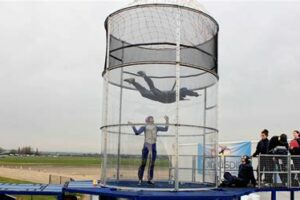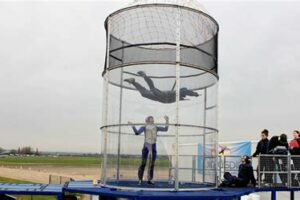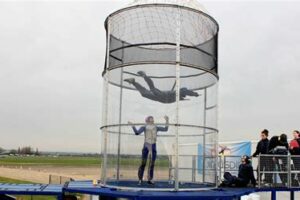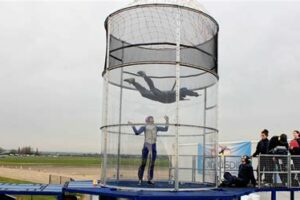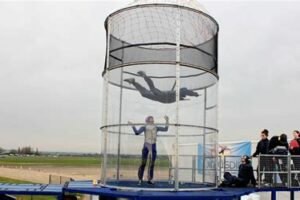Table of Contents
Discover the thrill of indoor skydiving and find out if it’s as challenging as it seems. Unleash your inner adventurer and experience the sensation of freefall without jumping from an airplane. Explore the techniques, skills, and adrenaline rush involved in this exhilarating sport. Dive into the world of indoor skydiving and see if you have what it takes to conquer the wind tunnels!
Indoor skydiving is an exhilarating and gravity-defying activity that has gained immense popularity in recent years. Whether you are a thrill-seeker or simply curious about defying the laws of physics, this adrenaline-pumping experience is sure to leave you breathless. But just how difficult is indoor skydiving? Well, let me guide you through the intricacies of this extreme sport and unveil the challenges that await even the most daring adventurers. So, buckle up, put on your safety goggles, and prepare to enter the world of indoor skydiving!
Introduction
Indoor skydiving is a thrilling and unique experience that allows individuals to experience the sensation of freefalling without jumping out of an airplane. This adrenaline-pumping activity takes place in a vertical wind tunnel where participants can float in mid-air, mimicking the feeling of a real skydive. Many people wonder if indoor skydiving is hard, but with the right instructions and guidance, it can be an enjoyable and accessible activity for people of all ages and fitness levels.
Understanding the Basics
Before delving into the specifics of indoor skydiving, it’s important to understand the basic concepts behind this exciting sport. The vertical wind tunnel generates a powerful upward airflow that allows participants to float above a trampoline-like netting, creating the illusion of freefalling. The wind speed can be adjusted to accommodate different skill levels and preferences, providing a safe and controlled environment to practice and enjoy the experience.
Gearing Up
Like any physical activity, there are certain gear requirements for indoor skydiving. Fortunately, you won’t need a parachute or extensive equipment. Participants typically wear a jumpsuit, helmet, goggles, and earplugs to protect themselves from the wind and noise generated by the vertical wind tunnel. These items are provided by the facility, ensuring that everyone has the necessary gear to participate safely.
Learning Body Positioning
A crucial element in indoor skydiving is mastering the correct body positioning. Maintaining stability and balance in the wind tunnel can be challenging at first, but with practice, it becomes easier. Instructors will guide participants on the proper body posture, which involves arching the back, extending the legs, and keeping the chin up. By maintaining this position, participants can maximize their stability and control during the experience.
Controlling Movements
Once you have mastered the basic body positioning, it’s time to learn how to control your movements in the wind tunnel. Small adjustments in body posture and limb positions can have a significant impact on your stability and ability to move around within the airflow. Instructors will teach participants how to shift their weight, bend their knees, and use their arms to maneuver and maintain control during the flight.
Building Confidence
Indoor skydiving can be an intimidating experience for some individuals, especially those who have never tried anything similar before. However, instructors are trained to create a safe and supportive environment that helps build confidence throughout the session. They will provide encouragement, guidance, and feedback to ensure participants feel comfortable and empowered during their indoor skydiving experience.
Progressing to Advanced Techniques
For those who become hooked on the exhilaration of indoor skydiving, there are opportunities to progress to more advanced techniques. Once you have mastered the basics, you can start learning exciting maneuvers such as turns, flips, and even formation flying with other participants. These advanced techniques require additional skills and practice, but they add an extra level of excitement and challenge to the indoor skydiving experience.
Staying Safe
Safety is of utmost importance in any adventure sport, and indoor skydiving is no exception. Facilities have strict safety protocols in place to ensure the well-being of participants. Instructors are trained professionals who will guide and supervise every flight, ensuring that all necessary precautions are taken. Additionally, participants are required to follow instructions, wear appropriate gear, and disclose any medical conditions that may affect their ability to safely participate.
Enjoying the Experience
Above all, indoor skydiving is meant to be an enjoyable and exhilarating experience. It offers individuals a unique opportunity to defy gravity, experience the sensation of flight, and push personal boundaries. Whether you are looking for an adrenaline rush, a fun activity with friends and family, or a way to conquer your fears, indoor skydiving provides an unforgettable experience that can be enjoyed by everyone.
Conclusion
Indoor skydiving is not hard when approached with the right mindset, proper instruction, and a willingness to learn. With the help of experienced instructors, participants can quickly grasp the basics, gain confidence, and enjoy the thrill of floating in mid-air. So why not give it a try? Indoor skydiving offers a safe and accessible way to experience the exhilaration of freefalling without the need to jump out of an airplane.
Is Indoor Skydiving Hard: Instructions and Tips
Welcome to the world of indoor skydiving! This guide aims to provide you with tips and instructions to make your indoor skydiving experience enjoyable and successful. Whether you’re a complete beginner or have some prior experience, read on to discover how to make the most of this thrilling activity.
1. Required Gear and Safety Precautions:
To ensure a safe and enjoyable experience, it is essential to wear appropriate gear, which includes a jumpsuit, helmet, goggles, and closed-toe shoes. Follow the instructions provided by your instructor carefully to ensure proper gear usage. Additionally, listen attentively to the safety briefing and ask any questions you may have before starting.
2. Body Positioning and Correct Technique:
Maintaining the correct body position and technique is crucial for indoor skydiving. Keep your body straight, engage your core, and maintain a relaxed posture. Spread your arms wide to support your balance, and keep your legs slightly bent. Listen carefully to your instructor’s advice regarding body positioning and apply them throughout your flight.
3. Breathing and Relaxation:
It is natural to feel excited or nervous during indoor skydiving, but remember to control your breathing and relax. Taking deep and steady breaths will help you remain calm and focused. Avoid tensing your muscles and try to envision yourself as weightless, floating effortlessly in the air.
4. Airflow Management:
Understanding how to manage airflow in the wind tunnel is essential. Tilt your head slightly forward to help direct air pressure towards your chest, keeping your body stable. Experiment with small adjustments in your body positioning to find the optimal airflow for balance and stability.
5. Communication with Your Instructor:
Clear communication with your instructor is essential, especially during your first few sessions. Make sure to speak up if you have any concerns or if you don’t understand certain instructions. Your instructor is there to guide and assist you, so never hesitate to ask for help.
6. Overcoming Challenges:
Indoor skydiving may present some challenges, particularly if it is your first time. Stay patient and persistent, as it takes time to perfect your technique. Remember that falling is part of the learning process, so embrace it as an opportunity to improve. Trust the instructor’s guidance and continue practicing to overcome any obstacles.
7. Progression and Skill Development:
As you gain more experience and confidence, you can progress to more advanced maneuvers and techniques. Consistency is key to improving your indoor skydiving skills. Attend regular sessions to build muscle memory and enhance your abilities gradually.
8. Enjoying the Experience:
Above all, remember to have fun and enjoy the experience of indoor skydiving! Embrace the sensation of weightlessness and the thrill of flying. Stay positive, be open to learning, and savor every moment of this unique adventure.
Conclusion:
Indoor skydiving may seem challenging at first, but with the right mindset, proper technique, and guidance from your instructor, it can be a rewarding and exhilarating activity. Follow these instructions and tips to make the most of your indoor skydiving experience, and let the wind carry you to new heights!
In my opinion, indoor skydiving can be a challenging activity for beginners. However, by following the instructions and guidelines provided, you can make the experience easier and more enjoyable. Here are some points to consider:
-
Wear appropriate clothing: Make sure to wear comfortable clothes that allow for ease of movement. Avoid loose items like jewelry or scarves that could get caught in the wind tunnel.
-
Listen to the instructor: Pay close attention to the instructions given by the instructor before entering the wind tunnel. They will guide you on proper body positioning and hand signals to communicate with them during the flight.
-
Focus on body control: Maintaining the correct body position is crucial for stability and control while indoor skydiving. Keep your arms extended in front of you, chin up, and legs slightly bent to maintain balance.
-
Breathe and relax: It’s natural to feel a bit nervous during your first indoor skydiving experience, but try to stay calm and breathe deeply. Relaxing your body will help you achieve better stability and control.
-
Use the wind to your advantage: The force of the wind in the tunnel can be used to lift or lower your body. Adjusting your body’s angle and position will enable you to move up or down within the wind tunnel.
-
Practice makes perfect: Like any new skill, indoor skydiving takes practice to master. Don’t get discouraged if you find it challenging at first. Keep practicing and refining your techniques to improve your performance.
-
Enjoy the experience: While indoor skydiving may require some effort and concentration, don’t forget to have fun! Embrace the feeling of flight and enjoy the unique sensation of defying gravity in a safe and controlled environment.
By following these instructions and adopting a positive mindset, you can overcome the initial difficulty of indoor skydiving and fully enjoy the exhilarating experience it offers. Remember, always prioritize safety and listen to the guidance of the instructors throughout your session.
Thank you for visiting our blog and taking the time to read about indoor skydiving. We hope that this article has provided you with valuable information and insights into the world of this exhilarating activity. As you may have gathered from our discussion, indoor skydiving is not as hard as it may seem at first glance. In fact, it offers a thrilling and accessible alternative to traditional outdoor skydiving.
Firstly, let us assure you that indoor skydiving is suitable for individuals of all fitness levels and ages. Whether you are a beginner or an experienced skydiver, indoor skydiving is an activity that can be enjoyed by everyone. The controlled environment of the indoor skydiving facility allows for a safe and enjoyable experience, giving you the opportunity to defy gravity and experience the sensation of freefall in a controlled and secure manner.
Transitioning from outdoor to indoor skydiving may take some adjustment, but with proper instruction and practice, it becomes an exciting and rewarding adventure. The key is to follow the instructions provided by the professional instructors at the facility. They will guide you through the process, teaching you the correct body positions and techniques to maintain stability and control during your flight. Additionally, they will ensure that you are equipped with all the necessary safety gear to make your experience as safe as possible.
In conclusion, we hope that this article has answered any questions you may have had about the difficulty level of indoor skydiving. Rest assured that indoor skydiving is not a difficult activity, but rather a thrilling and accessible one. With the right guidance and practice, anyone can enjoy the sensation of freefall and the adrenaline rush that comes with it. So, if you’ve ever dreamt of flying, indoor skydiving provides the perfect opportunity to do so in a safe and controlled environment. We encourage you to give it a try and experience the joy of defying gravity firsthand!
Thank you once again for visiting our blog. We hope you found this article informative and inspiring. If you have any further questions or would like to share your own indoor skydiving experiences, please feel free to leave a comment below. Happy flying!
Video Is Indoor Skydiving Hard
People Also Ask: Is Indoor Skydiving Hard?
1. How difficult is indoor skydiving?
Indoor skydiving can be challenging for beginners as it requires a certain level of physical coordination and body control. However, with proper instruction and practice, most individuals can quickly grasp the techniques and enjoy the experience.
2. Do you need any prior experience to try indoor skydiving?
No prior experience is required to try indoor skydiving. It is suitable for people of all ages and fitness levels. The facility will provide you with a training session that covers the necessary skills and safety procedures before your flight.
3. What skills do I need for indoor skydiving?
To excel in indoor skydiving, you should focus on body positioning and balance. Learning to maintain stability while controlling your movements is crucial. The instructors will guide you on how to position your body and make adjustments mid-flight.
4. Is there a weight limit for indoor skydiving?
The weight limit for indoor skydiving varies from one facility to another. Generally, it ranges between 250 and 300 pounds (113-136 kg). It is advisable to check with the specific facility beforehand to ensure you meet their weight requirements.
5. Can I get hurt while indoor skydiving?
Indoor skydiving is generally considered safe, and serious injuries are rare. However, as with any physical activity, there is a minimal risk of minor bumps, bruises, or muscle strains. It is essential to follow the instructions given by the instructors to minimize the chances of injury.
Overall, while indoor skydiving may seem challenging at first, it is a thrilling and enjoyable activity that can be enjoyed by individuals of various skill levels. With proper guidance and practicing the techniques taught during the training session, you can have a rewarding experience soaring through the air in a controlled indoor environment.

